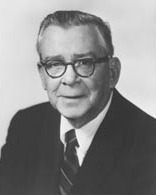George W. Andrews
George William Andrews | |
|---|---|
 | |
| Member of the U.S. House of Representatives from Alabama's 3rd district | |
| In office March 14, 1944 – January 3, 1963 | |
| Preceded by | Henry B. Steagall |
| Succeeded by | District inactive |
| In office January 3, 1965 – December 25, 1971 | |
| Preceded by | District inactive |
| Succeeded by | Elizabeth B. Andrews |
| Member of the U.S. House of Representatives from Alabama's at-large district | |
| In office January 3, 1963 – January 3, 1965 | |
| Preceded by | George M. Grant |
| Succeeded by | Kenneth A. Roberts |
| Personal details | |
| Born | December 12, 1906 Clayton, Alabama, U.S. |
| Died | December 25, 1971 (aged 65) Birmingham, Alabama, U.S. |
| Political party | Democratic |
| Spouse | |
| Children | 2 |
| Alma mater | University of Alabama at Tuscaloosa |
| Occupation | lawyer, politician, judge |
George William Andrews (December 12, 1906 – December 25, 1971) was an American politician and a U.S. Representative from Alabama, and the husband of Elizabeth B. Andrews.
Andrews is known for objecting to the Supreme Court decision banning school prayer by saying, "They put the Negroes in the schools and now they've driven God out."[1][2]
Biography
Andrews was born in Clayton, Alabama son of George William and Addie Bell (King) Andrews. He attended the public schools, and graduated from the University of Alabama at Tuscaloosa in 1928. He was admitted to the bar in 1928 and commenced practice in Union Springs, Alabama. On November 25, 1936, he married Leslie Elizabeth Bullock.
Career
He served as district attorney for the third judicial circuit of Alabama, from 1931 to 1943. During the Second World War, he served as a lieutenant (jg.) in the United States Naval Reserve from January 1943 until his election to Congress, at which time he was serving at Pearl Harbor, Hawaii.[3]
Andrews was elected as a Democrat to the Seventy-eighth Congress to fill the vacancy caused by the death of Henry B. Steagall. He was reelected to the fourteen succeeding Congresses and served from March 14, 1944, until his death from complications following heart surgery in Birmingham, Alabama on December 25, 1971.
Andrews was a signatory to the 1956 Southern Manifesto[4] that opposed the desegregation of public schools ordered by the Supreme Court in Brown v. Board of Education. Andrews voted against the Civil Rights Acts of 1957,[5] 1960,[6] 1964,[7] and 1968[8] as well as the 24th Amendment to the U.S. Constitution[9] and the Voting Rights Act of 1965.[10]
Death and legacy
Andrews died in Birmingham, Alabama on December 25, 1971, 13 days after turning 65. He is interred at Oak Hill Cemetery, Union Springs, Alabama.[11] The George W. Andrews Lake and George W. Andrews Federal Building are named for him.
See also
References
- ^ Nordlander, Robert E. (October 8, 1988). "The Making Of A Modern Myth". Archived from the original on September 11, 2018. Retrieved September 10, 2018.
- ^ Lewis, Anthony (June 26, 1962). "Supreme Court Outlaws Official School Prayers in Regents Case Decision" (PDF). The New York Times. p. 2. Retrieved January 4, 2023.
- ^ "George W. Andrews". Biographical Directory of the United States Congress. Retrieved May 19, 2013.
- ^ "Southern Manifesto" (PDF). Congressional Record - Senate: 4459–4461.
- ^ "HR 6127. CIVIL RIGHTS ACT OF 1957. -- House Vote #42 -- Jun 18, 1957". GovTrack.us. Retrieved January 12, 2024.
- ^ "HR 8601. CIVIL RIGHTS ACT OF 1960. APPROVAL BY THE … -- House Vote #106 -- Apr 21, 1960". GovTrack.us. Retrieved January 12, 2024.
- ^ "H.R. 7152. CIVIL RIGHTS ACT OF 1964. ADOPTION OF A … -- House Vote #182 -- Jul 2, 1964". GovTrack.us. Retrieved January 12, 2024.
- ^ "TO PASS H.R. 2516, A BILL TO ESTABLISH PENALTIES FOR … -- House Vote #113 -- Aug 16, 1967". GovTrack.us. Retrieved January 12, 2024.
- ^ "S.J. RES. 29. CONSTITUTIONAL AMENDMENT TO BAN THE USE OF … -- House Vote #193 -- Aug 27, 1962". GovTrack.us. Retrieved January 12, 2024.
- ^ "TO AGREE TO CONFERENCE REPORT ON S. 1564, THE VOTING … -- House Vote #107 -- Aug 3, 1965". GovTrack.us. Retrieved January 12, 2024.
- ^ "George W. Andrews". The Political Graveyard. Retrieved May 19, 2013.
![]() This article incorporates public domain material from the Biographical Directory of the United States Congress
This article incorporates public domain material from the Biographical Directory of the United States Congress
External links
- United States Congress. "George W. Andrews (id: A000206)". Biographical Directory of the United States Congress.
- George W. Andrews at Find a Grave